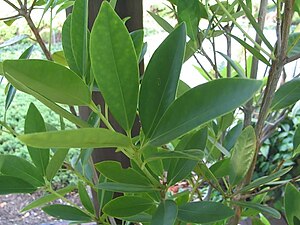Illicium verum/ja: Difference between revisions
Created page with "インド亜大陸の一部地域では、ビリヤニやマサラチャイの調味料として使用される。中華料理、マレー料理、インドネシア料理で広く使われている。中国、インド、その他のアジア諸国で商業用に広く栽培されている。八角は中華料理の伝統的なfive-sp..." Tags: Mobile edit Mobile web edit |
Created page with "===他種との鑑別=== ジョシら(Joshi ''et al.'')は蛍光顕微鏡とガスクロマトグラフィーを用いて種の鑑別を行っている一方、レデラーら(Lederer ''et al.'')はHPLC-MS/MSを用いた薄層クロマトグラフィーを採用している。" |
||
| (9 intermediate revisions by the same user not shown) | |||
| Line 54: | Line 54: | ||
[[:en:Indian subcontinent|インド亜大陸]]の一部地域では、[[biryani/ja|ビリヤニ]]や[[masala chai/ja|マサラチャイ]]の調味料として使用される。[[Chinese cuisine/ja|中華料理]]、[[Malaysian cuisine/ja|マレー料理]]、[[Indonesian cuisine/ja|インドネシア料理]]で広く使われている。中国、インド、その他のアジア諸国で商業用に広く栽培されている。八角は中華料理の伝統的な[[five-spice powder/ja|五香粉]]の材料の一つである。また、[[Vietnamese cuisine/ja|ベトナム]]の麺料理である[[phở/ja|フォー]]を作る際の主要な材料でもある。 | [[:en:Indian subcontinent|インド亜大陸]]の一部地域では、[[biryani/ja|ビリヤニ]]や[[masala chai/ja|マサラチャイ]]の調味料として使用される。[[Chinese cuisine/ja|中華料理]]、[[Malaysian cuisine/ja|マレー料理]]、[[Indonesian cuisine/ja|インドネシア料理]]で広く使われている。中国、インド、その他のアジア諸国で商業用に広く栽培されている。八角は中華料理の伝統的な[[five-spice powder/ja|五香粉]]の材料の一つである。また、[[Vietnamese cuisine/ja|ベトナム]]の麺料理である[[phở/ja|フォー]]を作る際の主要な材料でもある。 | ||
フランスのホットワインのレシピ、[[Mulled wine/ja|ヴァン・ショー]]にも使われる。コーヒーに浸しておくと、風味を深く豊かにする。このポッドは、熱湯の浸透によって味の成分の抽出が容易になるため、ポットやカップで何度も使用できる。 | |||
===医薬品前駆体=== | |||
{{Main/ja|Oseltamivir total synthesis/ja}} | |||
{{Main|Oseltamivir total synthesis}} | |||
スターアニスは、抗[[influenza/ja|インフルエンザ]]薬[[oseltamivir/ja|オセルタミビル]](タミフル)の[[drug/ja|医薬品]]合成における主要な[[precursor (chemistry)/ja|前駆体]]である[[shikimic acid/ja|シキミ酸]]の主要な供給源である。[[E. coli/ja|大腸菌]]の[[fermentation/ja|発酵]]を利用したシキミ酸の工業的生産方法は2005年に発見され、[[:en:2009 swine flu pandemic|2009年の新型インフルエンザパンデミック]]におけるタミフル不足に対処するために応用され、最終的にシキミ酸の[[raw material/ja|原料]]としての八角の価格高騰を逆転させた。2018年現在、大腸菌の発酵はタミフル合成のためのシキミ酸製造の選択された製造工程となっている。 | |||
< | <span id="Toxicity_of_related_species"></span> | ||
==Toxicity of related species== | ==関連種の毒性{{Anchor|Toxicity of related species}}== | ||
''トウシキミ(Illicium verum)''は毒性がない。しかし、他の関連種は毒性がある。 | |||
''Illicium verum'' | |||
類似の樹木である[[Japanese star anise/ja|シキミ]](''Illicium anisatum'')は毒性が強く食用にはならない。日本では代わりに[[:en:incense|線香]]として燃やされてきた。八角茶を使用した後に報告された「けいれんなどの重篤な[[neurological/ja|神経学的]]影響」を含む病気の事例は、この種による意図的な[[:en:economically motivated adulteration|経済的目的の混入]]の結果である可能性がある。シキミには[[neurotoxin/ja|神経毒]]である[[anisatin/ja|アニサチン]]が含まれており、これは摂取すると[[kidneys/ja|腎臓]]([[nephritis/ja|腎炎]])、[[urinary tract/ja|尿路]]、[[gastrointestinal tract/ja|消化器系]]の重度の[[inflammation/ja|炎症]]も引き起こす。 | |||
[[Japanese star anise]] | |||
米国南部で見られる類似の樹木であるスワンプスターアニス(''[[Illicium parviflorum/ja|Illicium parviflorum]]'')は毒性が強く、民間療法や料理の材料として使用すべきではない。 | |||
==ISO標準化{{Anchor|ISO Standardization}}== | |||
==ISO Standardization== | * [[:en:ISO|ISO]] 676:1995 – 品種および栽培品種の命名法に関する情報が含まれている。 | ||
* [[ISO]] 676:1995 – | |||
===同定=== | |||
== | * 『[[:en:European Pharmacopoeia|欧州薬局方]]』第4版(1153)を参照のこと。 | ||
* | |||
===他種との鑑別=== | |||
ジョシら(Joshi ''et al.'')は[[:en:fluorescent microscopy|蛍光顕微鏡]]と[[gas chromatography/ja|ガスクロマトグラフィー]]を用いて種の鑑別を行っている一方、レデラーら(Lederer ''et al.'')は[[:en:HPLC|HPLC]]-[[:en:MS/MS|MS/MS]]を用いた[[:en:thin layer chromatography|薄層クロマトグラフィー]]を採用している。 | |||
===仕様=== | ===仕様=== | ||
Latest revision as of 14:10, 16 June 2025
| Illicium verum/ja | |
|---|---|

| |
| トウシキミ(Illicium verum) がアメリカ国立樹木園にあるる | |

| |
| 八角の果実と種子 | |
| Scientific classification | |
| Kingdom: | Plantae |
| Clade: | Tracheophytes |
| Clade: | Angiosperms |
| Order: | Austrobaileyales |
| Family: | Schisandraceae |
| Genus: | Illicium |
| Species: | verum
|
| Binomial name | |
| verum | |
| Synonyms | |
| |
Wikの翻訳 カスタム Gem トウシキミ(Illicium verum)(八角、スターアニス、チャイニーズスターアニス、スターアニスシード)は、中国南部およびベトナム北東部原産の中型の常緑樹である。熟す直前に収穫される星形をしたその果皮は、アニスに風味がよく似たスパイスである。主な生産国は中国で、ベトナムや他の東南アジア諸国がそれに続く。八角油は非常に香りが高く、料理、香水、石鹸、歯磨き粉、うがい薬、スキンクリームなどに使用される。2012年に遺伝子組み換え大腸菌を使用するようになるまで、ロシュ・ファルマシューティカルズはシキミ酸を介してオセルタミビル(タミフル)を製造するために、世界の年間八角収穫量の最大90%を使用していた。
語源と命名法
| スターアニス | |||||||||||||||||||
|---|---|---|---|---|---|---|---|---|---|---|---|---|---|---|---|---|---|---|---|
| Chinese | 八角 | ||||||||||||||||||
| Literal meaning | "eight-horns" | ||||||||||||||||||
| |||||||||||||||||||
Illicium はラテン語のillicioに由来し、「誘惑する」または「魅惑する」を意味する。
Verumは「真の」または「本物の」を意味する。
「badian」という名称は、フランス語のbadianeを経由して、どうやら中国語の描写的な名称である八角(pinyin: bājiǎo、文字通り「八つの角」)に由来するようである。しかし、ペルシャ語のبادیان bādiyān、「フェンネル」からの派生も存在し、オックスフォード英語辞典は、それ以前の語源は不明であるとしている。
特徴
葉は芳香があり、単葉で披針形、倒卵形から楕円形、または楕円形で、大きさは5–15 cm × 2–5 cm、革質から厚い革質である。葉は5–15 cm × 1.5–5 cmで、先端は鋭尖形、裏面には柔毛がある。花は単生、両性、ピンクから濃い赤色で、葉腋または亜頂生である。花被片は7–12枚でらせん状に配置され、雄しべは11–20本でらせん状に配置され、短く太い花糸を持つ。心皮は通常8個で離生し、単一の輪に配置される。花柄の大きさは1.5–4 cm、花被片は7–12枚で、広楕円形から広卵形、葯の大きさは1–1.5 mm、花粉粒は三合溝型である。
果実は袋果状の集合果で、星形、赤褐色であり、6個から8個の袋果が輪生している。各袋果は舟形をしており、長さは1–2 cm、粗く硬く、色は赤褐色で、種子が1個入っており、熟すと腹側縁に沿って開裂する。心皮の長さは10 mmで舟形であり、硬くしわがあり、種子を1個含む。種子は褐色、扁圧した卵形、滑らかで光沢があり脆く、おおよその大きさは8–9 mm × 6 mmである。
類似する分類群との違い: Illicium anisatumは果実が小さく、一部の心皮が不稔のため規則的な星形を形成しない。また、果実の袋果の中央は膨らんでおらず、先端はより尖っている。通常8個以上の袋果があり、果実の香りは弱い。Illicium anisatumの種子は平坦またはほぼ球形である。
用途
料理用途


スターアニスには、無関係な植物であるアニスに風味を与えているのと同じ化合物であるアネトールが含まれている。スターアニスは欧米では、製パンにおいてアニスの安価な代替品として、またリキュール製造において、特にガリアーノの製造において、その特徴的な風味で利用されるようになった。八角は肉の風味を高める。
インド亜大陸の一部地域では、ビリヤニやマサラチャイの調味料として使用される。中華料理、マレー料理、インドネシア料理で広く使われている。中国、インド、その他のアジア諸国で商業用に広く栽培されている。八角は中華料理の伝統的な五香粉の材料の一つである。また、ベトナムの麺料理であるフォーを作る際の主要な材料でもある。
フランスのホットワインのレシピ、ヴァン・ショーにも使われる。コーヒーに浸しておくと、風味を深く豊かにする。このポッドは、熱湯の浸透によって味の成分の抽出が容易になるため、ポットやカップで何度も使用できる。
医薬品前駆体
スターアニスは、抗インフルエンザ薬オセルタミビル(タミフル)の医薬品合成における主要な前駆体であるシキミ酸の主要な供給源である。大腸菌の発酵を利用したシキミ酸の工業的生産方法は2005年に発見され、2009年の新型インフルエンザパンデミックにおけるタミフル不足に対処するために応用され、最終的にシキミ酸の原料としての八角の価格高騰を逆転させた。2018年現在、大腸菌の発酵はタミフル合成のためのシキミ酸製造の選択された製造工程となっている。
関連種の毒性
トウシキミ(Illicium verum)は毒性がない。しかし、他の関連種は毒性がある。
類似の樹木であるシキミ(Illicium anisatum)は毒性が強く食用にはならない。日本では代わりに線香として燃やされてきた。八角茶を使用した後に報告された「けいれんなどの重篤な神経学的影響」を含む病気の事例は、この種による意図的な経済的目的の混入の結果である可能性がある。シキミには神経毒であるアニサチンが含まれており、これは摂取すると腎臓(腎炎)、尿路、消化器系の重度の炎症も引き起こす。
米国南部で見られる類似の樹木であるスワンプスターアニス(Illicium parviflorum)は毒性が強く、民間療法や料理の材料として使用すべきではない。
ISO標準化
- ISO 676:1995 – 品種および栽培品種の命名法に関する情報が含まれている。
同定
- 『欧州薬局方』第4版(1153)を参照のこと。
他種との鑑別
ジョシら(Joshi et al.)は蛍光顕微鏡とガスクロマトグラフィーを用いて種の鑑別を行っている一方、レデラーら(Lederer et al.)はHPLC-MS/MSを用いた薄層クロマトグラフィーを採用している。
仕様
- ISO 11178:1995 – ドライフルーツの仕様
参照
| この記事は、クリエイティブ・コモンズ・表示・継承ライセンス3.0のもとで公表されたウィキペディアの項目Illicium verum(24 May 2025, at 09:49編集記事参照)を翻訳して二次利用しています。 |